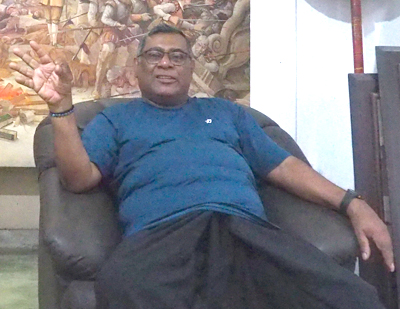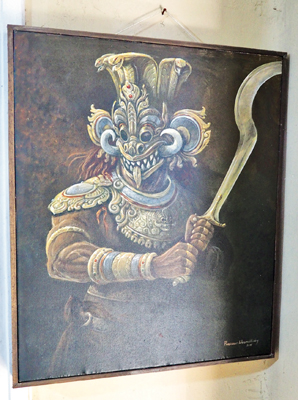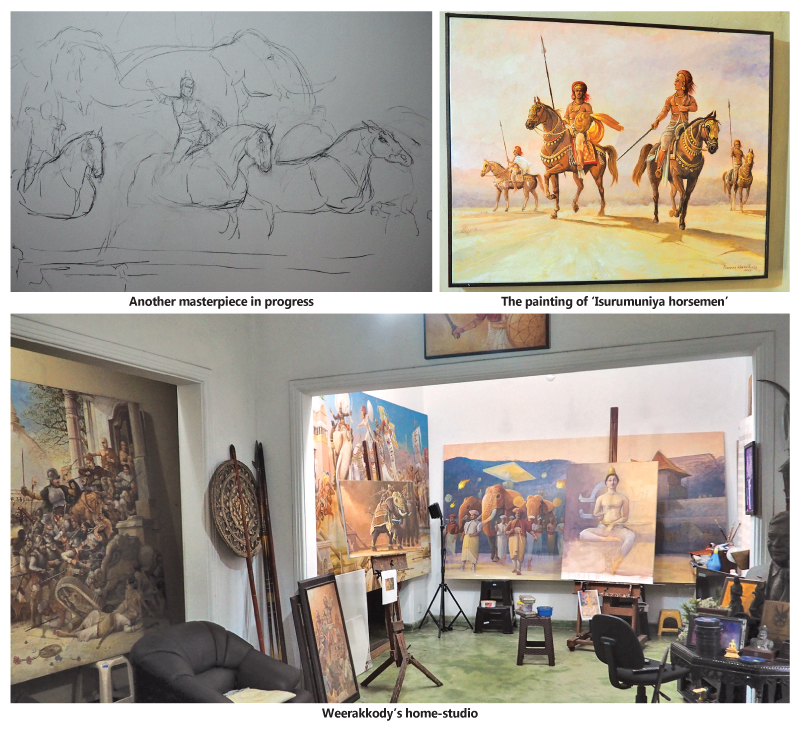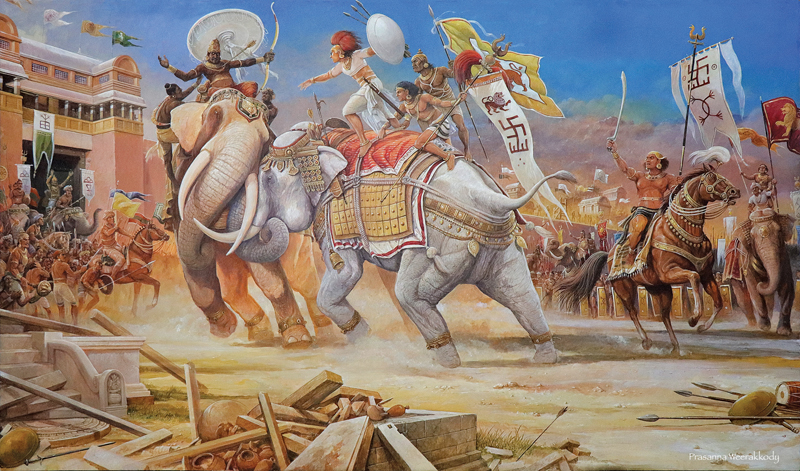I felt like Marty McFly from Back to the Future when I stepped into Prasanna Weerakkody’s home in Kirulapone. But unlike Dr. Emmett Brown’s DeLorean, this artist’s time machine wasn’t powered by 1.21 gigawatts—it was his home-studio, lined with canvases that transport viewers through centuries of Sri Lankan history.
 Weerakkody welcomed me with a warm smile as I raised my camera to snap pictures. “That one’s not ready yet, so don’t take any,” he cautioned. His home-studio was a modest bungalow overflowing with art. Hanging in the living room were some of his most iconic works, including Fall of Elara and Desecration of the Kelaniya Temple—paintings that captured pivotal moments in Sri Lanka’s past.
Weerakkody welcomed me with a warm smile as I raised my camera to snap pictures. “That one’s not ready yet, so don’t take any,” he cautioned. His home-studio was a modest bungalow overflowing with art. Hanging in the living room were some of his most iconic works, including Fall of Elara and Desecration of the Kelaniya Temple—paintings that captured pivotal moments in Sri Lanka’s past.
Art that defined a Movement
When a mural-painting trend swept across Sri Lanka in early 2020, it was Weerakkody’s work that artists most frequently copied and recreated. Looking at his originals, one immediately understands why. His paintings don’t just depict history—they evoke it.

Prasanna Weerakkody
Born into an artistic family, Weerakkody was destined to be a painter. His father, Ariyawansa Weerakkody, was a renowned sculptor, while his mother was an art teacher. Initially drawn to wildlife painting, he later found his true calling in historical art, meticulously reconstructing Sri Lanka’s battle-laden past.
A Warrior culture on canvas
“Sri Lanka has faced so much conflict that the Sinhalese are essentially a warrior culture, much like the Japanese samurai, European knights, and the African Zulus,” Weerakkody explained. He pointed out that traces of ancient armour still survive in the elaborate wes costume worn by Kandyan dancers. “The chest piece made of strung pearls resembles chainmail. Then there are shoulder pads, arm rings, a groin guard, and shin guards. According to legend, this costume was derived from half of the Malaya king’s battle dress.” Beyond the canvas, Weerakkody played a key role in designing the Presidential ceremonial Rana Parashuwa (battle axe) and the regimental Rana Parashuwa for the Special Forces. These were based on historical weapons like the kasthane (sabre) and the angam katta (ornamented machete), reflecting the martial traditions of Sri Lanka’s past.
Rediscovering forgotten history
Weerakkody spends countless hours researching historical texts, museum archives, and temple murals. A recurring theme in his work is the famed Isurumuniya horseman. “Historical sources describe the ancient Sri Lankan cavalry as wearing plumed helmets—something more commonly associated with Greek and Roman soldiers than with the Indian subcontinent. I’ve tracked down two or three references confirming this,” he said.
Another of his paintings depicts a stoic soldier standing on a collapsing rampart. When asked about it, Weerakkody shared a personal connection: his family name originates from warriors who carried battle flags, and the painting is a tribute to an ancestor who fought during the Seethawaka period.
Moving into another section of the studio, he showed me an unfinished painting. The outlines depicted war elephants and cavalry charging into battle.
“In the second siege of Colombo Fort by Rajasinghe I, he mustered 2,000 elephants—600 of them trained for war. They wore armour, wielded swords in their trunks, and had daggers affixed to their tusks. They were the tanks of their time,” he said. “Interestingly, Sri Lanka exported elephants, despite having so many. Greek sources mention Sri Lankan elephants being particularly violent and well-suited for war, while the imported ones were more docile, meant for pageants.”
Controversies and legacy

‘Yaksha Warrior’ painting
Weerakkody’s work has not been without controversy. Some critics argue that paintings like Fall of Elara promote tribalism and ethnic nationalism. He dismisses this notion: “History is history. There was an event, and I am depicting that event. We can’t deny what happened.” He also pointed out how historical symbols evolve over time, citing the swastika in his paintings. “It was once an auspicious symbol before an evil regime co-opted it into a mark of hate.” His influence on Sri Lankan art became undeniable when mural artists in 2020 began replicating his paintings. “At first, I was flattered. I recorded over a hundred murals featuring my work. Some bridges had multiple of my paintings copied. But when some artists started claiming my work as their own, I had to call them out. Copying is fine, but credit the original artist,” he said. Looking back, however, he feels a sense of accomplishment. “When people wanted to depict our history, it was my work they turned to.”
Future of Art and AI
On the topic of AI-generated art, Weerakkody isn’t concerned. “No one is making AI-generated ‘Prasanna Weerakkody paintings’ because AI lacks the depth of historical research behind my work. It will never capture the details the way I do.” He advises contemporary artists to study art deeply rather than relying on shortcuts or fleeting social media trends.
Looking ahead, Weerakkody plans to return to his roots with a series of wildlife paintings alongside other prominent artists. He is also working with young filmmakers to ensure historical accuracy in upcoming period films.
A timeless legacy
Through his art, Weerakkody has ensured that Sri Lanka’s past is not only remembered but vividly brought to life. His paintings are more than just images—they are historical testimonies rendered in colour and form. And as long as there are stories to tell, his brush will continue to serve as Sri Lanka’s time machine.





